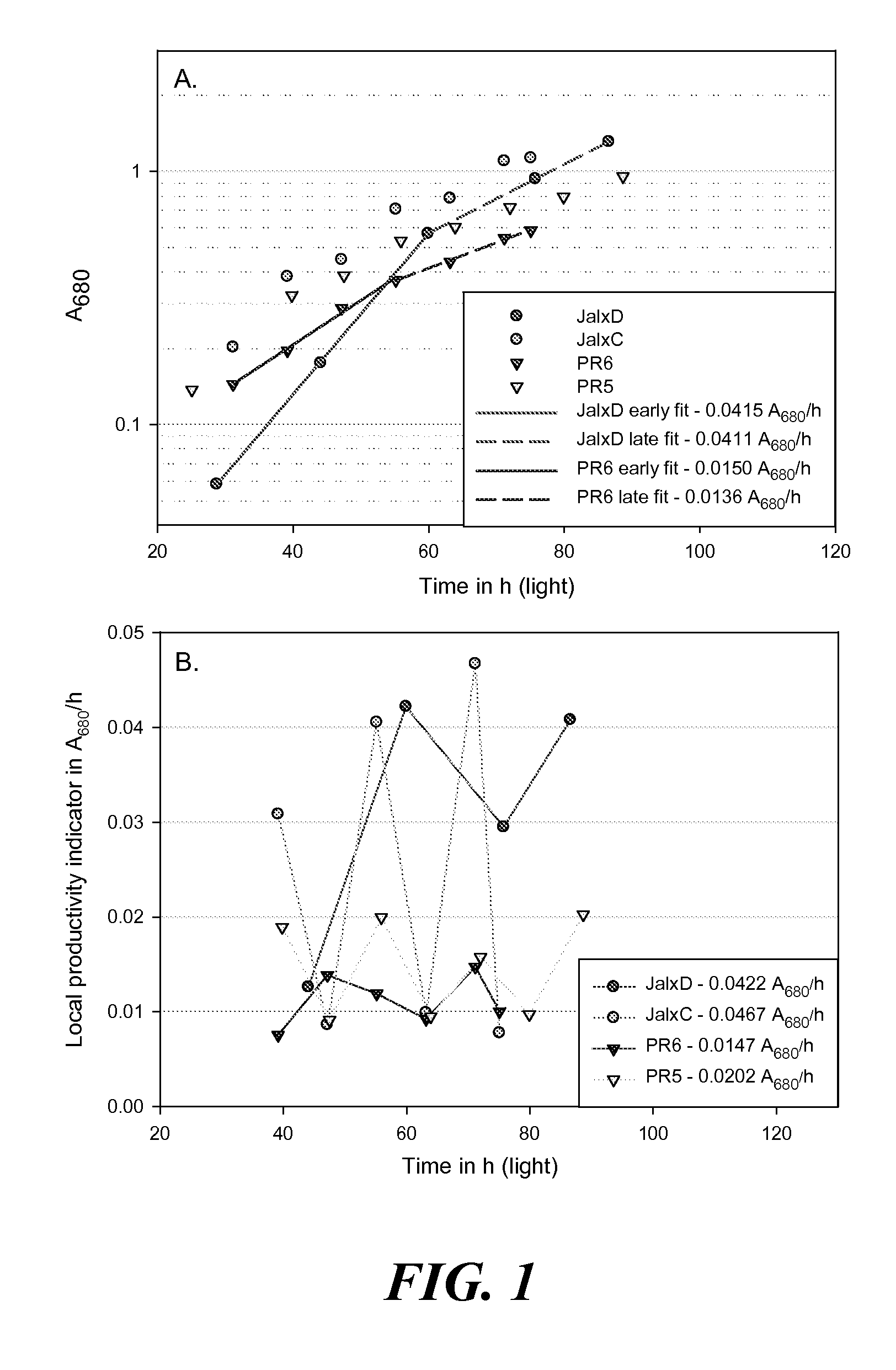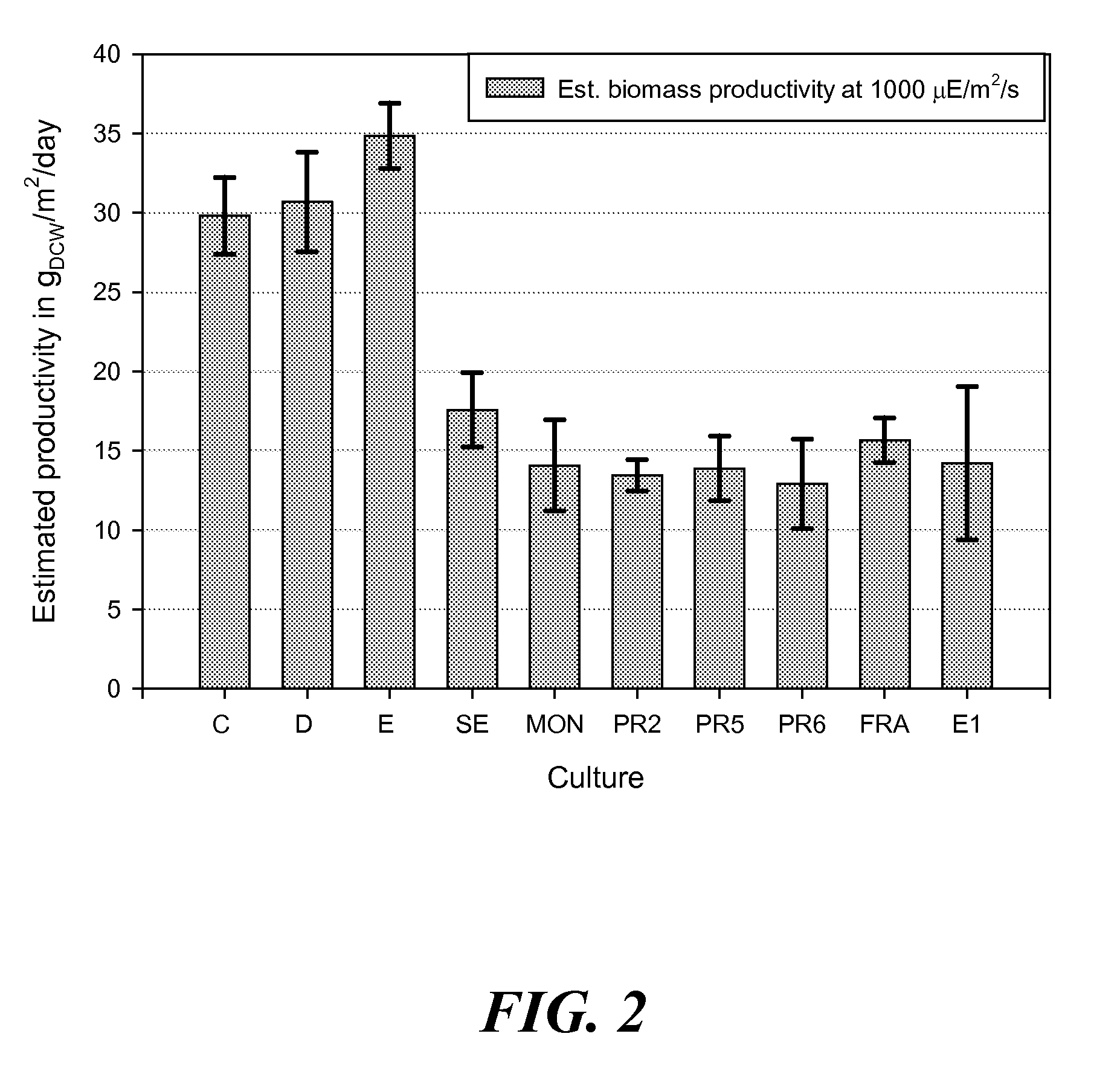Methods for estimating intrinsic autotrophic biomass yield and productivity in unicellular photosynthetic algae
- Summary
- Abstract
- Description
- Claims
- Application Information
AI Technical Summary
Benefits of technology
Problems solved by technology
Method used
Image
Examples
example 1
Determination of the Exponential-to-Linear Transition Autotrophic Yield ΦDCW,ELT In Aerated Algae Cultures Under Nutrients-Replete Conditions
Cultures Origins and Growth Conditions
[0241]The FLX media recipes are detailed in Table I.
TABLE IFLX growth media recipeFINALCONCENTRATION IN MMSTOCK SOLUTIONSSTERILIZATIONFLX1FLX10FLX50FLX100NaClAUTOCLAVED2548240480MgCl2AUTOCLAVED15.62356KClAUTOCLAVED11510CaCl2AUTOCLAVED0.20.212MgSO4AUTOCLAVED0.30.322TRIS PH 7.6AUTOCLAVED10VITAMINS10.22 μM FILTERSEE BELOWMICRONUTRIENTS20.22 μM FILTERSEE BELOWIRON III30.22 μM FILTER0.010 (ADDED FRESH UPONINOCULATION)Na2SiO30.22 μM FILTER0.2 (FORBACILLARIOPHYCEAE ONLY)NaH2PO4AUTOCLAVED0.3NaNO3AUTOCLAVED3NH4Cl21Vitamins, final concentration in ng / L: thiamine 67, biotin 0.25, vitamin B12 152Micronutrients, final concentration in μM: ZnSO4 0.8, MnCl2 0.9, Na2MoO4 0.026, CoCl2 0.042, CuSO4 0.039, Na2EDTA 50, H3BO3 1003The iron III was supplied upon inoculation as a FeCl3:Sodium citrate 1:3 stock (molar ratio)
[0242]T...
example 2
Growth Behavior for Carbonate-Amended Cultures and Determination of Heightened Autotrophic Yields
[0254]See Example 1 for cultures origins, growth conditions and analytical methods, with the following modifications: the nitrogen source supplied was 3 mM nitrate (not 3 mM nitrate and 2 mM ammonium as in Example 1), and the flask was sealed according to the Carbonate Addition Method (CAM) (not aerated as in Example 1). Sealing was performed by placing autoclaved aluminum foil over the flask aperture, which was then covered hermetically with PARAFILM.
[0255]Compared to the aerated cultures in FIG. 1, the algae cultures grown using CAM displayed perfect exponential growth behaviors as shown in FIG. 4, where the light / dark dependent ‘stair-like’ behavior (see FIG. 1) was alleviated. This perfect exponential behavior for each culture (either early exponential, solid line, or late exponential, hatched line) allowed for the determination of the early Fitted Productivity Estimate (FPI, defined...
example 3
Determination of the Williams-Duarte Autotrophic Yield ΦDCW,WD
[0257]See Example 1 for cultures origins, growth conditions, and analytical methods, with the following modifications: the nitrogen source supplied was 3 mM nitrate (not 3 mM nitrate and 2 mM ammonium as in Example 1), and the flask was sealed according to the Carbonate Addition Method (CAM) as described in Example 2 (i.e., not aerated as in Example 1).
[0258]In order to test the validity of the Williams model modified to reflect the use of the Duarte chlorophyll-specific autotrophic extinction coefficient, the Left-Hand Side of Equation 14 was plotted as a function of time (see FIG. 6) for four algae cultures grown in nutrients-replete, carbonate-amended conditions. The slope corresponds to ΦCh1 (g Ch1 / μEABSORBED), from which ΦDCW, WD can be estimated using Equation 15. As expected from Equation 14, the function describes a straight line for all cultures. Non-zero intercepts, observed for some cultures, may reflect physi...
PUM
 Login to View More
Login to View More Abstract
Description
Claims
Application Information
 Login to View More
Login to View More - R&D
- Intellectual Property
- Life Sciences
- Materials
- Tech Scout
- Unparalleled Data Quality
- Higher Quality Content
- 60% Fewer Hallucinations
Browse by: Latest US Patents, China's latest patents, Technical Efficacy Thesaurus, Application Domain, Technology Topic, Popular Technical Reports.
© 2025 PatSnap. All rights reserved.Legal|Privacy policy|Modern Slavery Act Transparency Statement|Sitemap|About US| Contact US: help@patsnap.com



